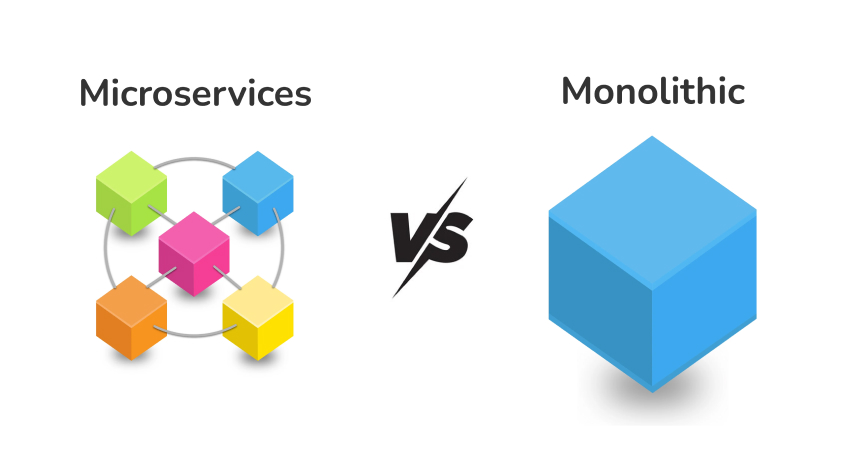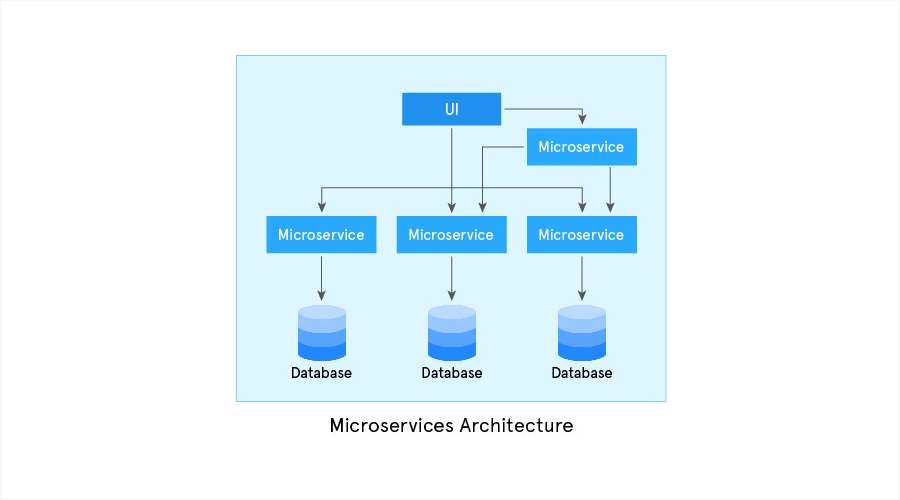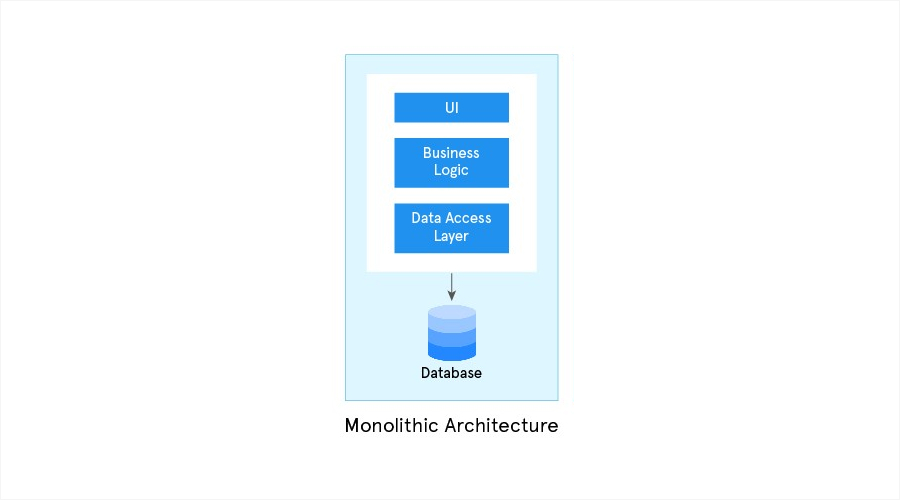
A decade ago, most people were unfamiliar with the terms like microservices and monolithic architecture. And why not? These terms are more for those who belong to the software development world. Software developers are more concerned with how to design the application because it impacts their complete business, and that’s when these two architectures come in handy. If you are also a developer, knowing the difference between Microservices Architecture vs Monolithic Architecture is crucial. This will help you make an informed decision on how to create a compelling application to grab the attention of consumers and for ease of business. Read this article to learn about these two different architectures that most web development services India use. Let’s get started…
What Is Microservices Architecture?

Microservices architecture (often known as microservices) is an architectural method for developing applications. It allows applications to be divided into small, independent parts, each with its business capability and responsibility. Every service can be developed, updated, tested, deployed, and scaled independently. It does not share the database with other microservices; each microservice consists of its own database.
Most importantly, it leads to the duplication of the data. There should be an independent database for every microservice to ensure loose coupling. Typically, services can communicate with each other over a network in a loosely coupled manner using HTTP protocols or messaging queues. Let’s now take a look at the advantages of Microservices architecture…
Advantages of Microservices Architecture
Some of the common advantages of microservices architecture are as follows:
- Agility: Microservices architecture enables team members to quickly develop, test, deploy, and scale services. It allows for a rapid application development cycle. This way, the developer ensures that the product should be launched on time to take advantage of market opportunities.
- Scalability: Microservices allow for individual features of applications to be scaled independently. This simply means that you can scale the parts of applications according to your requirements. There is no need for you to be concerned about the scaling of the entire application.
- Flexibility: Microservices allow team members to explore the best technologies and languages to support the software development process. It avoids putting limitations on their use of technologies to meet specific requirements. As a result, developers can ensure an optimal application.
- Resilience: Microservices decouple a large application into independent databases. As a result, a failure in one service does not impact the development cycle of the application. It reduces downtime and promotes the software’s resilience to a great extent.
- High Performance: Based on the testing results, microservices architecture allows developers to deploy changes for a specific service. It does not trigger the risk of changing the entire application.
- Easy Maintenance: Since each individual service is smaller and has a limited scope of specific functionalities, microservices architecture allows developers to update and maintain the codebase with ease. This, in turn, ensures the faster development of the application.
It’s now time to take a look at the downsides of microservices architecture in software development. Here we go…
Disadvantages of Microservices Architecture
Here are some of the most common disadvantages of using a microservices architecture. Take a look…
- Heavy Infrastructure Cost: Yes, it’s a costly affair. Every new microservice can make developers pay for services, test suites, deployment services, monitoring tools, and more. This, in turn, increases the overall cost of developing the application.
- Complexity: In contrast to monolithic architecture, microservices add more layers of complexity to the system because of the multiple teams involved during the process. If the leader fails to manage the development process, it can lead to a slower delivery process, increased infrastructure costs, and poor operational performance.
- Debugging Issues: Finding and fixing errors or bugs in microservices is more complex than finding and fixing monolithic architecture. Microservices architecture’s debugging is complicated because individual database services have their own set of logs.
- Lack of Standardization: Since there is no common platform, microservices architecture can confront the issue of no logging standards, languages, and monitoring.
- Increased Organizational Overhead: To ensure an efficient application development process, team members need to manage communication services to coordinate real-time updates. The high network latency and data serialization/deserialization increase overhead costs.
- Testing: Microservices architecture requires a comprehensive testing strategy, ensuring the product is not vulnerable to malware attacks. It includes integration testing services, as well as, individual testing for each small service.
What Is Monolithic Architecture?

Monolithic architecture is a conventional software development model. It uses a single code base to perform multiple business functions. In this method, software developers use traditional strategies to design software. They build an entire application in a single unit. In this model, a single codebase performs multiple functions in an application. Also, different components of the application, including the user interface, data access layer, and business logic, are integrated.
In contrast to microservices architecture, it couples all business concerns together. With the modification or redeployment of monolith architecture, developers ensure changes or updates to the application. The best part is that its interface is intuitive and compatible with small and medium-sized applications.
However, it can be complex and time-consuming for large-size applications. It is crucial to select a reputable web development service provider in USA if you want your application to be built using Monolithic architecture.
Advantages of Monolithic Architecture
Here are some of the best advantages of monolithic architecture for you to be aware of. Take a look…
- Simplicity: Monolithic architecture is known for its capability to help create simple applications. With a monolithic structure, developers can build a unified unit that stores all the codes of an application in one place. It becomes easy to understand how the different parts of an application function together. Since it couples different business concerns, the communication between services becomes smooth and seamless. This, in turn, simplifies the overall development process.
- Speedier Development: The monolithic architecture allows for speedier development. Since monolithic architecture allows the integration of all the parts together, this results in the quick development of the application. Developers can update or change the codebase without modifying the entire application. All in all, monolith architecture ensures a faster product development cycle.
- Deployment: Managing the deployment of a monolithic application is simpler compared to microservices. This is because developers need to use only one artifact in a monolithic application. Consequently, it reduces the risk of deployment errors to a great extent.
- Debugging: Debugging is one of the major concerns when it comes to software development. However, monolithic architecture makes debugging a breeze for developers. This is because it enables team members to integrate everything in one application. This gives software developers the flexibility to use tools to fix bugs and errors before they become severe.
- Testing: Since monolithic architecture is a centralized unit, it uses end-to-end testing to test the software. The testing procedure for a unified unit is faster than for distributed applications.
Undoubtedly, monolithic architecture offers numerous advantages; however, it does have some disadvantages as well and knowing them is crucial if you are a software developer or want to become in the future. Read on!
Disadvantages of Monolithic Architecture
Here are some of the most common disadvantages of monolithic architecture. Take a look…
- Complex Architecture: Monolithic architecture is more complex and difficult to manage, especially if the size of the application is large. It becomes challenging for developers to understand how different components communicate with one another in an application. Consequently, it leads to slower development times and an increased risk of deployment errors.
- Difficult to Scale: Scaling monolithic applications is a taxing task for developers. This is because all the parts of the application are coupled together, which makes it difficult for developers to scale the application. Scaling one component causes scaling of the entire application. It becomes more difficult when specific parts handle a large volume of traffic. Additionally, scaling can add to the overall cost of the applications in monolith architecture.
- Limitations in Technologies Usage: Unlike microservices, monolithic architecture restricts developers to choosing technologies and tools according to the specified requirements of an application. The lack of flexibility in choosing technology results in a limited set of features within an application.
- Deployment: Deployment of a monolithic architecture is often considered time-consuming and inefficient. This is because it restricts developers from making any changes to the component. Instead, it encourages deployment in the entire monolith. Consequently, it increases the risk of longer deployment times and errors.
- Downtime Issues: Monolithic architecture is a single-unit centralized system. If any component fails, it can make applications more susceptible to downtime and unreliable.
Let’s now understand how these two architectures differ. Here are the differences between the two. Read on!
Difference Between Microservices and Monolithic Architectures
Now that you have learned the ins and outs of microservices and monolithic architectures. It’s time to discover the difference between Microservices architecture and Monolithic architecture in a simplified manner. Look at the following pointers to figure out how microservices are different from monolithic architectures:
➜ Code Based
Microservice architecture relies on distributed applications. It restricts developers from using a single code base to divide the application into several services. Instead, it harnesses the power of an API to interact with different components. Conversely, the monolithic architecture uses a single code base to build server-side and centralized applications.
➜ Development Process
Well-structured planning and design are vital to start with the microservice architecture. Developers need to find functions that can work independently and consistently with APIs. Effective coordination between services makes code maintenance efficient and cost-effective. As a result of this, bugs are identified faster and the development takes a shorter time.
➜ Deployment
The deployment of microservices is more complex than the deployment of monolithic architecture. Developers usually containerize each service before initiating deployment, making the procedure difficult. On the other hand, monolithic architecture allows developers to install the entire application code base in a single database.
➜ Debugging
Debugging in microservices architecture makes it challenging to identify erratic applications because several developers are accountable for varied services. Since it requires coordination for updates and interfaces, it is time-consuming and resource-intensive. By contrast, debugging monolith architecture allows developers to examine the code base within the same programming environment.
➜ Modifications
It is easier to change and modify features in microservices. Developers can alter specific features without affecting the entire system’s ecosystem. On the contrary, a small change in one part of the monolithic architecture can affect the comprehensive application because all components are tightly coupled.
➜ Scaling
Microservices follow the distribution system. Developers can scale each service independently and efficiently. Conversely, monolithic architecture restricts the independent scaling of features. It contains all functionalities in a single-user-based application. Therefore, developers need to change the entire application when the requirements alter. This makes software development in monolithic architecture a less efficient and expensive procedure.
➜ Innovative
When it comes to comparing microservices and monolithic architecture, microservices are more innovative. Developers use cutting-edge technologies and different frameworks in microservices. It is due to loosely coupled components. In contrast, monolithic architecture is less technological and more rigid. It avoids the integration of new technologies to enhance the capabilities of the application.
➜ Minimum Risks
Microservices and monolithic architecture experience bugs and errors. However, they are varied in the context of deployment risks. Developers prefer microservices to mitigate deployment error risks. If any microservice fails, the others remain operational. On the contrary, a monolithic application is at a greater risk. It is vulnerable to the entire system’s failure. Additionally, it may cause service outages.
➜ Total Cost
Microservice is more cost-effective than monolithic architecture. For scaling, developers only need to add resources for service. They do not need to change the entire application. This factor makes it comparatively affordable. Conversely, the expenses of monolithic applications are higher. This is because sometimes developers run them on newer software.
➜ Application Size
Microservices architecture builds a complex system. It provides a robust programming foundation for the team. It helps them enhance their capabilities and skills. The monolithic approach is less complicated because of the single code base. Therefore, developers prefer it when designing a simple application. Sometimes, it requires substantial time and design efforts.
➜ Team Competency
For microservices, team members should be well-versed in the APIs, cloud architecture components, containerization, and other specific technologies. Further, troubleshooting microservices applications is challenging for new developers. Since monolithic architecture limits technologies, its team members need not to have expertise in various things.
➜ Infrastructure
Though microservices applications can run on a single server, developers prefer the cloud environment. This is because it ensures scalability, high availability, and reliability. On the contrary, monolithic applications run on a single server and are highly preferred for building simple and intuitive applications.
Wrapped It Up
So, this all about microservices architecture and monolithic architecture. All in all, both the two architectures are used in software development. However, it is worth noting that monolithic architecture has become obsolete. It is a conventional procedure that is rarely used these days. On the other hand, Microservices architecture is flexible and cloud-based, which is why, developers find them the most suitable. Amazon AWS, Netflix, and other web platforms are based on microservices because of their applications’ needs, flexibility, and ease of use.
Thanks for reading this post. Hopefully, this article has been informative for you. We believe that the insight shared in the article will help you choose the best architecture based on your business-specific requirements. Stay tuned for more such insightful articles!






